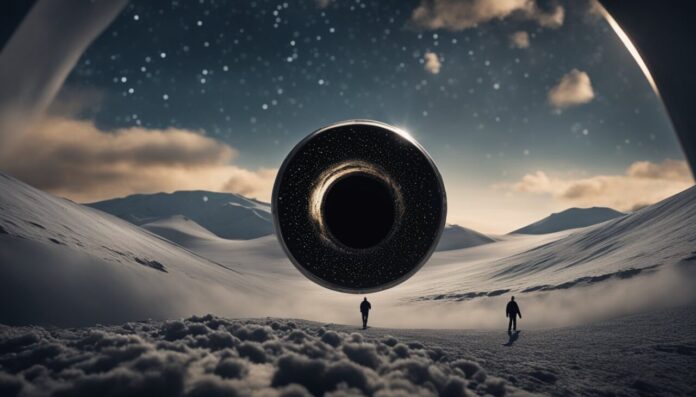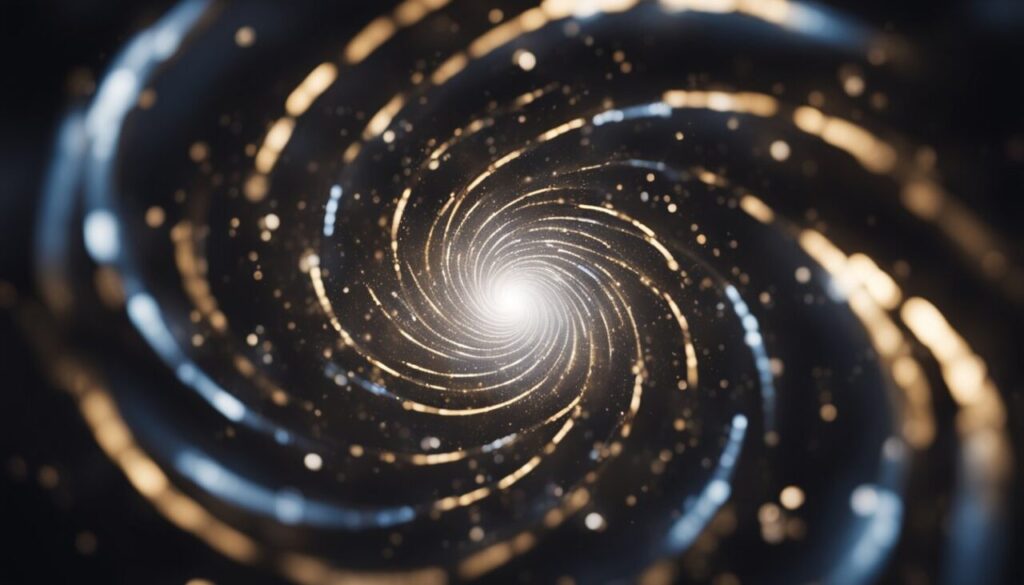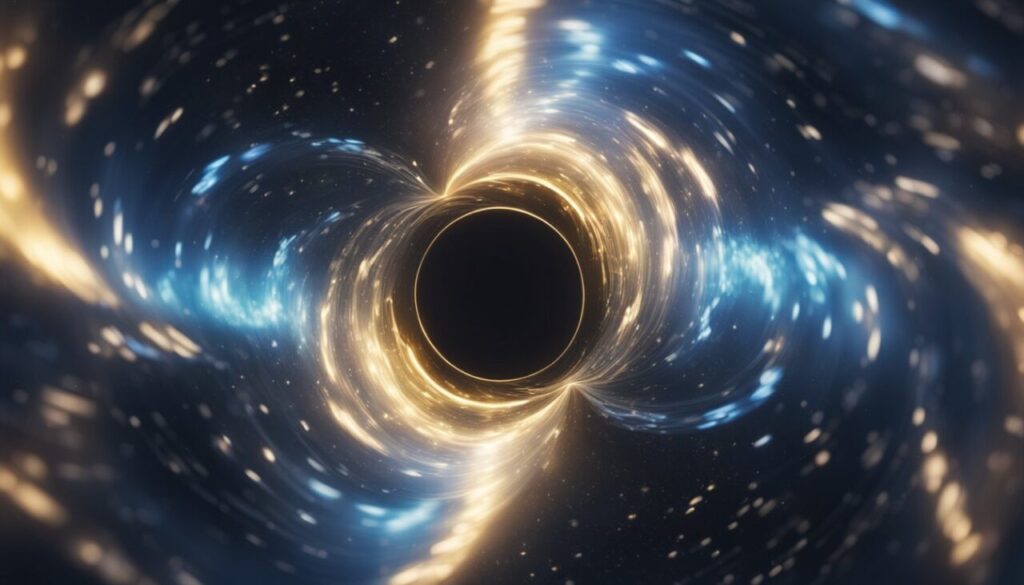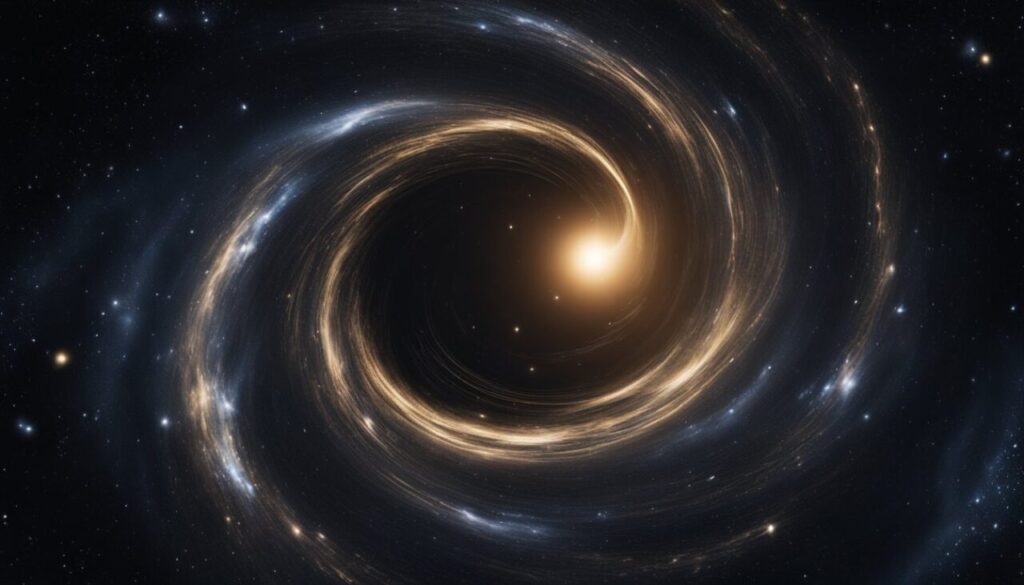
Black holes are rather fascinating. These mysterious cosmic objects are known for their intense gravitational pull, which is so strong that even light cannot escape once it crosses the event horizon. We don’t understand many things about black holes but we do wonder about their intriguing physics characteristics.
Moreover we’re often thinking about different hypothetical scenarios.
And one of those is:
- What would happen if a human fell into a black hole?
So let’s try to answer this question straight away and then we’ll delve deeper into the topic.
Related:
What Would Happen If You Fell Into Black Hole?

Falling into a black hole is a terrifying concept. But what would actually happen if you fell into one? In short, you would be stretched out like a noodle in a process called “spaghettification” and eventually crushed into a singularity.
To explain this in simpler terms, imagine you are falling feet-first into a very strong gravitational field. As you get closer to the black hole, the gravity becomes stronger and stronger, stretching your body out into a long, thin shape. This is because the gravity is stronger at your feet than your head, causing a tidal force that pulls you apart.
As you get closer to the black hole, the tidal forces become stronger and stronger until they rip you apart completely. This is the point of no return, known as the event horizon. Once you cross the event horizon, there is no escaping the black hole’s gravity.
As you continue to fall towards the singularity at the center of the black hole, the tidal forces become even stronger, stretching you out into a long, thin strand of matter.
Eventually, you would be crushed into a single point of infinite density known as a singularity.
As we concluded, black holes are rather complex subject which is hard to explain, and falling into one is even harder to explain so let’s try with ELI5 concept.
ELI5 Version:
- Imagine having an enormous vacuum cleaner in space. However, instead of cleaning up dirt, this cosmic vacuum cleaner sucks up everything around it, resembling a colossal cosmic whirlpool. Its power is so strong that even light, typically the fastest entity in the universe, cannot escape from its grasp.
- That’s why we call it a ‘black hole‘—it’s akin to a hole in space where everything disappears. Now, right at the center of this cosmic vacuum cleaner, there’s a compressed point known as the ‘singularity.’
- Picture squeezing Play-Doh plasteline as small as possible, but even tinier than that! This point possesses the strongest gravity imaginable, acting like a powerful magnet for everything in its vicinity.
In summary, falling into a black hole is a one-way trip to a violent and gruesome end. The gravity of the black hole would stretch you out into a long, thin shape and eventually crush you into a singularity.
Okay, so with that quick explanation let’s dive deeper into the physics of black holes, event horizon, singularity, time dilatation and many other interesting topics.
Physics Of Black Hole

As mentioned, a black hole is a region in space where the gravitational pull is so strong that nothing, not even light, can escape it. The physics of a black hole is fascinating and complex. In this section, we will explore some of the key concepts related to black holes.
Event Horizon
The event horizon is the boundary around a black hole beyond which nothing can escape. Once an object crosses the event horizon, it is pulled towards the singularity at the center of the black hole. The event horizon is determined by the mass and size of the black hole. The larger the mass and size of the black hole, the larger the event horizon.
Singularity
The singularity is the point at the center of a black hole where the gravitational pull becomes infinite. It is a point of zero volume and infinite density. The laws of physics as we know them break down at the singularity level. The singularity is hidden behind the event horizon, so it cannot be observed directly.
Gravitational Time Dilation
Gravitational time dilation is a phenomenon where time appears to slow down in the presence of a strong gravitational field. This effect is caused by the curvature of spacetime around a massive object like a black hole. As an object gets closer to a black hole, time appears to slow down relative to an observer far away from the black hole. This means that time passes more slowly for an object near a black hole than for an observer far away.
In conclusion, the physics of a black hole is rather complex topic. The event horizon, singularity, and gravitational time dilation are just a few of the key concepts related to black holes. As mentioned we still don’t understand many things with regards to black holes.
Recommendation: If you’re really interested in black holes, we couldn’t recommend better book than this one, written by Brian Cox and Jeff Forshaw: “Black Holes: The Key to Understanding the Universe“
Theoretical Journey Into Black Hole?

And so, let’s dive deeper into our imaginary journey to black holes.
Spaghettification
If a person were to fall into a black hole, they would experience a phenomenon known as “spaghettification” . As the person gets closer to the black hole, the gravitational forces become stronger, and the difference in gravity between their feet and head becomes more significant. This difference causes the person’s body to stretch out like a piece of spaghetti, with their feet getting closer to the black hole than their head
During the spaghettification process, the person’s body would be stretched out to the point where it would break apart into individual atoms The atoms would then be pulled towards the black hole’s singularity, where they would be compressed into an infinitely small point.
Interesting Fact: The term “spaghettification” was coined by famed astrophysicist Stephen Hawking in his book A Brief History of Time. It vividly describes the stretching and compression of objects as they approach a black hole.
Observation from the Outside Of The Black Hole
From the outside, the process of spaghettification would appear to happen in slow motion. As the person gets closer to the black hole, their body would appear to stretch out longer and thinner until it eventually disappears into the black hole’s event horizon.
Once the person crosses the event horizon, they would be lost forever. The event horizon is the point of no return, where the gravitational pull of the black hole becomes so strong that nothing, not even light, can escape its grasp.
Overall, falling into a black hole would be a one-way journey that would end in a person’s destruction.
Hawking Radiation: A Twinkle of Hope?

While falling into a black hole seems like a one-way ticket to oblivion, there is a theoretical glimmer of hope offered by the late physicist Stephen Hawking.
Hawking proposed that black holes are not entirely black; they can emit a faint glow of particles now known as Hawking radiation. Over an immensely long period, this radiation could cause a black hole to lose mass and eventually evaporate. However, this process is incredibly slow, and for all practical purposes, it would not offer a viable escape route for anyone unfortunate enough to find themselves inside a black hole.
Interesting Fact: Hawking radiation is temperature-dependent, which means that smaller black holes emit more radiation than larger ones. This might sound counterintuitive at first because you’d expect larger black holes to be “hotter,” but it’s actually the opposite.
Frequently Asked Questions

What observable phenomena occur as one approaches a black hole?
As one approaches a black hole, they may observe a few observable phenomena. The closer one gets to the black hole, the stronger the gravitational force becomes. This increased gravitational force can cause time dilation, where time appears to pass more slowly for an observer near the black hole than for someone farther away. Additionally, the strong gravity of the black hole can cause light to bend, leading to a phenomenon called gravitational lensing.
Is survival possible after crossing a black hole’s event horizon?
The event horizon of a black hole is the point of no return, beyond which even light cannot escape. Once an object crosses the event horizon, it is inevitably pulled towards the singularity at the center of the black hole. Therefore, survival after crossing the event horizon is not possible.
What are the theoretical predictions for the interior of a black hole?
The theoretical predictions for the interior of a black hole are quite bizarre. According to general relativity, the center of a black hole is a singularity, a point of infinite density where the laws of physics as we know them break down. Some theories predict that the singularity may be replaced by a region of highly curved spacetime known as a “wormhole”. However, the nature of the interior of a black hole still remains one of the biggest mysteries in modern physics.
What would be the implications for Earth if it were to encounter a black hole?
The likelihood of Earth encountering a black hole is extremely low. However, if such an event were to occur, the consequences would be catastrophic. The strong gravitational force of the black hole would cause Earth to be torn apart, with all matter being compressed into the singularity at the center of the black hole.
Is it feasible to escape a black hole once you have entered it?
Once an object has crossed the event horizon of a black hole, it is impossible to escape. The gravitational pull of the black hole is so strong that not even light can escape. Therefore, it is not feasible to escape a black hole once you have entered it.
Conclusion

In our exploration of what would happen if you fell into a black hole, we have encountered a series of mind-bending phenomena, from the inescapable event horizon to the stretching forces of spaghettification and the enigmatic singularity. We have also glimpsed the enticing possibility of Hawking radiation, which hints at the eventual demise of black holes over cosmic timescales.
However, one thing is true – black holes remain some of the most mysterious and awe-inspiring objects in the universe. They challenge our understanding of physics and beckon us to venture into the unknown.
While the question of what truly happens inside a black hole remains unanswered, our journey has shed light on the incredible forces and phenomena that shape these cosmic enigmas.
One thing is certain: the universe will continue to surprise, amaze, and challenge us, asking us to explore its depths with deep curiosity.
Note: If you’re interested in similar articles, on topic of “What if”, you can check:
- What If A Needle Hit The Earth At The Speed Of Light
- What If The Oceans Disappeared
- What Would Happen if Yellowstone Supervolcano Erupted
- What would happen if Gravity suddenly disappeared?
- What would happen if Sun exploded?
- What would happen if Jupiter disappeared?
- What would happen if Earth stopped spinning?
- What would happen if Moon exploded?



























